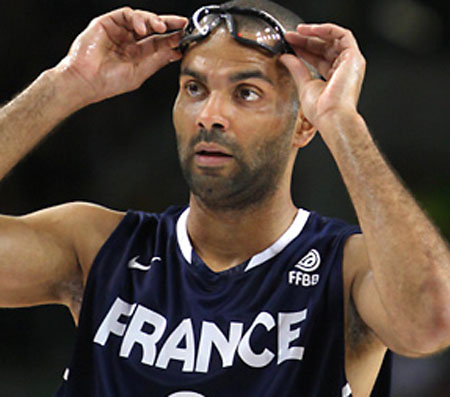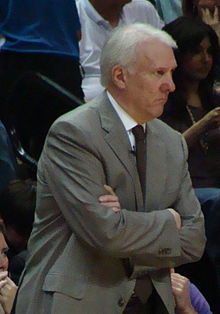This is the fourth in a five-part series on The History of the San Antonio Spurs (© Whitman Publishing, LLC), which was recently released and is written by Sheridanhoops.com columnist Jan Hubbard (twitter: @whyhub). In the third excerpt, Hubbard recounted the crafty dealings that went into the Spurs’ acquisition from the financially strapped Virginia Squires, who has traded Julius Erving to the New York Nets earlier this season. In this installment, the drafting of Tony Parker is described. (You can order the book here.)
 The journey began in Frankfurt, Germany, where Tony Parker boarded an airplane for a 15-hour flight to Chicago in June 2001. He was not a secret to NBA scouts. They knew he began playing professionally at age 15 in his native France and he was a tantalizing talent.
The journey began in Frankfurt, Germany, where Tony Parker boarded an airplane for a 15-hour flight to Chicago in June 2001. He was not a secret to NBA scouts. They knew he began playing professionally at age 15 in his native France and he was a tantalizing talent.
In international competition against players in his age group, he was often dominant. He had much to learn, but for a player who turned 19 a little more than a month before the 2001 draft, he had a unique set of skills and experience.
How that would convert to the NBA, however, was a mystery. Parker was not a great shooter. For a point guard, he was not a natural passer. But when he took off from one baseline to the other, it was like he was shot out of a rocket launcher. His on-court speed with the ball was as fast, if not faster, than any player in the world.
His first workout was with the Spurs. They had won the title two years earlier but were eliminated in the first round of 2000 playoffs when Tim Duncan was sidelined with a knee injury. In 2001, they lost to Shaquille O’Neal, Kobe Bryant and the Los Angeles Lakers, who were on their way to three straight championships.
The Spurs still had a talented roster and had the best record in the league, 58-24, during the regular season. But the Lakers were obviously a formidable opponent and the Spurs knew they needed to add talent, which was not going to be easy since they had only the 28th pick in the 2001 draft.
Spurs coaches and scouts were split on Parker, so they were curious to see how he played in a one-on-one matchup with Lance Blanks, then a front office employee with the team. Blanks had played three years in the NBA and despite being 34 and retired, he relished competition.
 With Parker suffering an acute case of jet lag, the 6-foot-4, 190-pound Blanks simply embarrassed him in the workout. Afterwards, Spurs coach Gregg Popovich spared no words with Parker and his agent. “I told both of them that he’s too soft and I’m looking for someone with more fiber and grit,” Popovich said. “He was nonchalant, like he was in a café outside of Momart in Paris having a glass of wine and a croissant. It didn’t seem to matter to him any more than that.
With Parker suffering an acute case of jet lag, the 6-foot-4, 190-pound Blanks simply embarrassed him in the workout. Afterwards, Spurs coach Gregg Popovich spared no words with Parker and his agent. “I told both of them that he’s too soft and I’m looking for someone with more fiber and grit,” Popovich said. “He was nonchalant, like he was in a café outside of Momart in Paris having a glass of wine and a croissant. It didn’t seem to matter to him any more than that.
But Parker didn’t feel that was a fair judgment. “I flew 15 hours and I landed and went straight to the workout,” Parker said. “I was tired and didn’t do well and Pop didn’t want to see me again.”
Personnel chief R.C. Buford had seen the 6-foot-2, 170-pound Parker play in a tournament against all the best players in the world in his age group, however, and was enamored with Parker’s abilities. So was Spurs basketball special assistant Sam Presti, now the general manager of the Oklahoma City Thunder. But all they heard from the rest of the coaching staff were complaints about Parker’s limitations.
It wasn’t enough to point out that the Spurs had only the last pick in the first round, so taking a chance on a long shot wasn’t a bad strategy. But they sought to convince the other coaches by making a video of Parker making plays in competition that he supposedly could not make.
Three days before the June 27 draft, the Spurs brought Parker to San Antonio for another visit. By that time, he had worked out for many teams and reports from each city had team personnel raving about Parker’s abilities.
In San Antonio, Parker had a brilliant workout that convinced Popovich and all the other coaches that he had a chance to be a great NBA player. Unfortunately for the Spurs, others were also convinced.
“We walked out of the workout and Pop said that it would take Tony no more than 10 games to start for the team that drafted him,” Buford said. “But that team was not going to be us. There were too many teams that needed a point guard drafting ahead of us. Some of them had multiple picks. We did everything to move up in the draft to take him, but we couldn’t make a deal. We went to the draft that night and we all knew there was no way he would last until 28.”
One team that reportedly fell in love with Parker was Boston. The Celtics had three picks – 10, 11 and 21 – but picked Joe Johnson (who turned out to be an All-Star player), and a pair of forgettables (Kedrick Brown and Joseph Forte).
Orlando needed a point guard to replace 32-year-old Darrell Armstrong and had the 15th and 22nd picks. The Magic surprised the Spurs, however, by taking Steven Hunter (who became a journeyman) and Jeryl Sasser (whose career lasted 82 games).
Toronto at 17, Utah at 24 and Sacramento at 25 had all worked out Parker and the Spurs were sure one of them would take him.
But each passed.
At 28, he was still available.
The Spurs were ecstatic.
“We couldn’t believe it,” Buford said. “We never thought he would fall to us, but it was just a series of things that kept happening and he kept slipping.”
Popovich turned out to be a prophet, albeit quicker than he thought. He said Parker would start after 10 games as a pro. After only five games, Popovich inserted him in the starting lineup to replace Antonio Daniels, and San Antonio went on to win 58 games, second most in the league. Parker’s rookie stats were modest – 9.2 points, 4.3 assists, 41.9 percent shooting from the field. But it was clear he had the potential to be a star player.
© Whitman Publishing, LLC
PREVIOUSLY: Excerpt #3: The crafty dealings that landed George Gervin in San Antonio
PREVIOUSLY: Excerpt #2: Colorful but futile start for Spurs franchise in Dallas
PREVIOUSLY: Excerpt #1: As Popovich nears 900 victories, a look at the early days
CHECK OUT JAN HUBBARD’S ARCHIVE FROM SHERIDAN HOOPS.COM. GREAT STUFF ON THE NBA THEN AND NOW.
Jan Hubbard has written about basketball since 1976 and worked in the NBA league office for eight years between media stints. Follow him on Twitter at @whyhub.